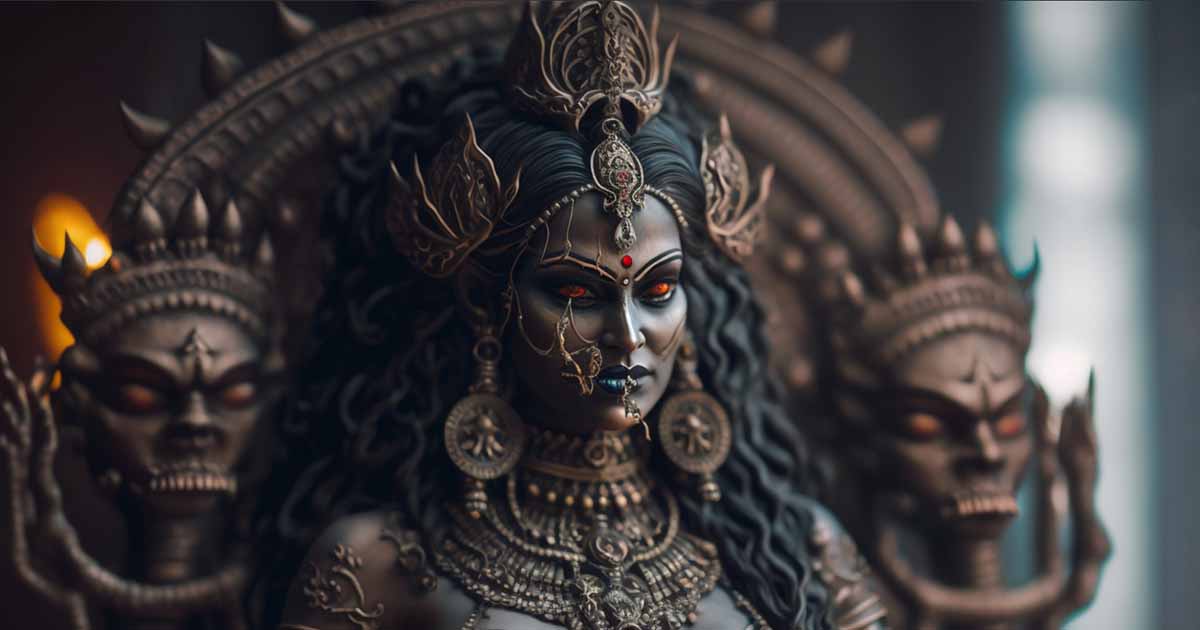10 Most Fearsome Gods in Ancient Mythology
Throughout the long ages of our collective history, gods and goddesses have been revered, worshiped, and feared. Ancient mythologies from around the world are rife with deities who instilled awe and dread in the hearts of their followers. These powerful beings, often embodying the primal forces of nature and human existence, held dominion over life and death, war and peace, chaos and order. Today, we delve into the stories of the ten most fearsome gods in ancient mythology, whose very names could strike terror into the hearts of mortals.
1. Zeus, the Thunderous Sovereign
Zeus, the king of the Greek gods, reigned supreme from his lofty seat on Mount Olympus. His thunderbolts and control over the weather made him a formidable and often wrathful deity. As the god of thunder and lightning, his storms were both majestic and terrifying. The folk believed that they depended on his mercy in order for their crops to either fail or succeed, and thus work extra hard to appease him. And when you depend on someone for your life and wellbeing - you are certain to fear him as well.
As the ruler of Mount Olympus, Zeus presided over the divine council of gods and goddesses, making important decisions and maintaining order among the deities. This is another factor that made him a revered god in ancient Greece. Zeus was a complex deity, known for both his wisdom and his quick temper. He could be just and fair in his judgments but could also be impulsive and vengeful when angered. For example, the myths tell us how Zeus punished Prometheus by having him bound to a rock where an eagle would eat his liver every day, only for it to regenerate each night and the painful ordeal to repeat endlessly. The wrath of this magnanimous deity was notorious.

Prometheus bound to a rock, his liver eaten by an eagle, in a print by Lucien. (Public domain)
2. Thor, the Great Striker
Thor, the Norse god of thunder, wielded his mighty hammer, Mjölnir, with unmatched strength. He defended the gods from giants and other threats, and the sound of thunder was believed to be the roar of his chariot. Often enough, Thor was portrayed as a witty and humorous god. But even so, he was feared far and wide, both by the folk who revered him, and his legendary enemies.
Thor could master the weather, calling down thunder and storms. The ancient Norse who revered him, knew that their crops could be destroyed by vicious summer thunderstorms. They believed such storms were the product of Thor’s wrath, and they went to great lengths to appease their wrathful god. Often, the way to appease him was sacrifice - sometimes human, sometimes animal. And still, the summer storms kept coming back…

Thor’s Fight with the Giants’ (1872) by Mårten Eskil Winge. (Public Domain)
3. Sekhmet, the Lioness of Wrath
In ancient Egypt, Sekhmet was a vicious goddess of war and destruction. Often depicted as a lioness, she brought plagues and pestilence upon her enemies, leaving no room for mercy. The ancient Egyptians were well known for their powerful and often merciless Gods. Sekhmet was one of the most feared in the entire pantheon. Sekhmet was primarily associated with war, destruction, and healing, and was thus both a protective and destructive force. Curiously, it was the enemies of Ancient Egypt who feared Sekhmet the most. Knowing that the Egyptian Pharaohs went into battle with her protection, the enemy armies cowered in fear. She was imagined as a fearsome half woman/ half lioness who would tear through the enemy ranks and bring death and pestilence. However, it was the swords and axes of the Egyptians that brought death, and a lioness never appeared.
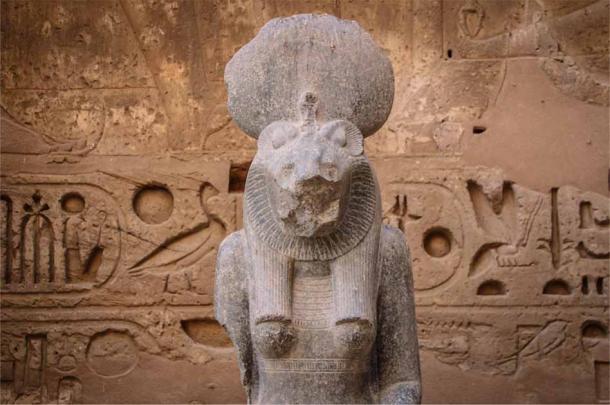
Statue of Sekhmet, Egyptian goddess with a lioness head. Known as the goddess of war and destruction (abrilla/Adobe Stock)
4. Hades, the Great Lord of the Underworld
Hades, the ruler of the underworld in ancient Greek mythology, inspired fear for his role in judging souls and the darkness of the afterlife. His realm was shrouded in mystery, and mortals dared not utter his name. The underworld, often referred to as the "House of Hades" or "Hades," was where the souls of the deceased would go after death. It was not a place of eternal torment like the Christian concept of Hell but rather a realm where souls existed in a shadowy, mystical state.
Despite his association with death, Hades was not inherently evil or malevolent. He was simply fulfilling his role as the ruler of the afterlife and guardian of the dead. But Hades was feared for his connection to death and the shadows of the underworld. Naturally superstitious, the ancient Greeks didn’t even want to utter his name. Of course, there was also the fear of his fearsome temper and his ability of cruel punishment. One myth mentions how Hades condemned Sisyphus to roll a huge boulder up a steep hill, only for it to roll back down when he was nearing the top, forcing him to start over again, repeating the cycle for all eternity.
- Hades, God of the Underworld and His Unsung Powers
- Legendary Ancient Musicians Charmed Beasts, Sirens and Even Hades Himself
5. Fearsome goddess Kali, the Dark Mother
Kali, a Hindu goddess of destruction and transformation, struck terror with her fearsome appearance. She wore a necklace of severed heads and had a tongue dripping with blood, symbolizing her ferocity. Kali is a powerful and complex deity in Hinduism, embodying both destructive and transformative aspects of the divine. She represents the inevitability of time, the dissolution of the ego, and the eternal cycle of life, death, and rebirth. Her devotees believe that invoking her can help break free from the cycle of birth and death and attain spiritual liberation (moksha).
Those who follow Kali seek her blessings for protection, the removal of obstacles, and the destruction of negative forces in their lives. They know that she is benevolent but very destructive as well, and thus they always fear and respect her. One unique myth tells us just how ferocious and powerful Kali was. The myth is that of her conquering the demon Raktabija. The demon Raktabija spawned clones of himself with every drop of his blood that hit the ground. The other gods called Kali in to help after they only succeeded in making an army of Raktabija clones. Fearing nothing, Kali prevented Raktabija from cloning himself by drinking every drop of his spilt blood. Then - she beheaded him.
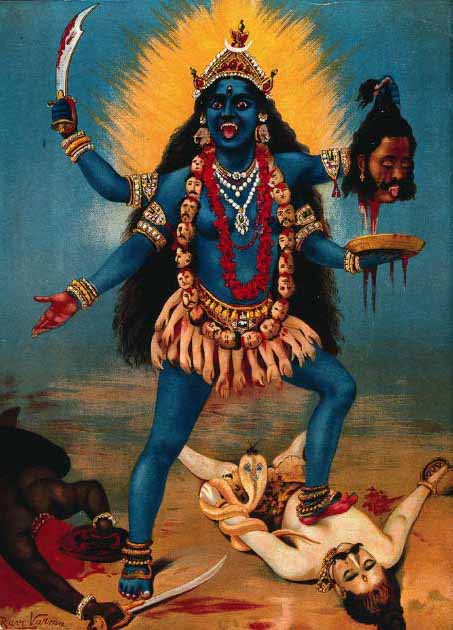
Kali, goddess of destruction and renewal, brandishing her sword and a severed head as she tramples her consort Shiva underfoot. (Public domain)
6. Ares, the God of War
Ares, the Greek god of war, reveled in the chaos and violence of battle. His impulsive and bloodthirsty nature made him a deity to be feared on the battlefield. Ares was the son of Zeus, the king of the gods, and Hera, the queen of the gods. He had a sister, Eris, who was the goddess of strife. While Ares was not as widely worshiped as some other gods, he had a presence in ancient Greek religious practices, particularly in areas associated with warfare. Soldiers feared him, and would work hard to gain his favor. Some cities had temples dedicated to Ares, where soldiers would offer sacrifices before going into battle, seeking his favor and protection. The ordinary folk, not accustomed to warfare, greatly feared him due to his connection with bloodshed. For them, he was the symbol of the destructive and brutal aspects of war.
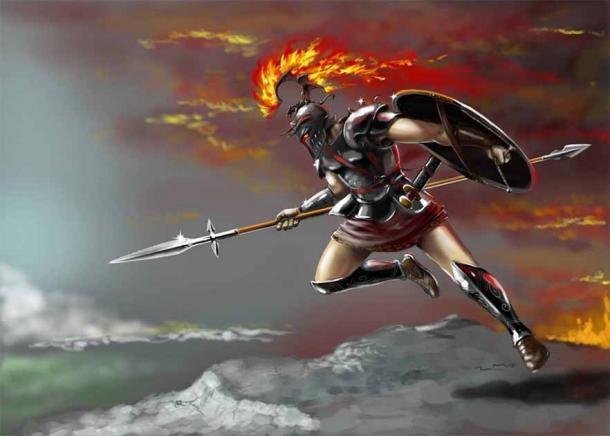
Ares, God of war. Source: Геннадий Кучин /Adobe Stock
7. Tiamat, the Primordial Chaos
In Babylonian mythology, Tiamat was a primordial goddess of chaos, taking the form of a monstrous dragon. She waged war against the younger gods, symbolizing the forces of chaos and destruction. One of the most fearsome ancient deities, she is a central figure in the Babylonian creation myth known as the Enuma Elish, where she is also the primary antagonist. She is depicted as amassing an army of monsters and chaos creatures to battle against the younger gods led by Marduk, who was chosen as their champion.
The battle between Tiamat and Marduk is a central theme in the myth and culminates in a fierce confrontation. Marduk ultimately defeats Tiamat, splitting her body into two and using one half to create the heavens and the other half to form the Earth. Tiamat represents the forces of chaos and disorder in the universe, which need to be subdued and controlled for creation and order to prevail. The Babylonians greatly feared her, but also respected her, because they knew destruction and chaos were fundamental parts of every existence.
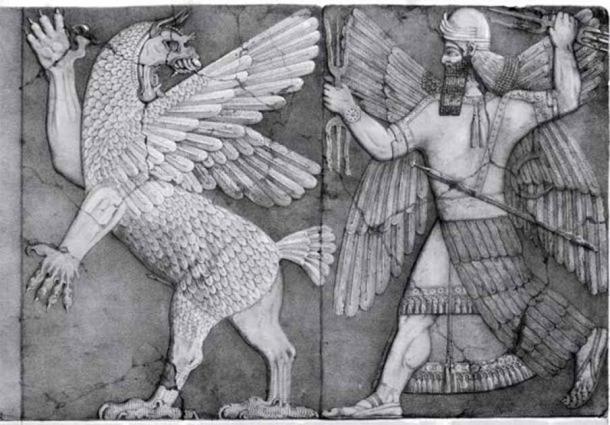
A chaos monster (perhaps Tiamat), and a sun god, perhaps Marduk. (TYalaA/CC BY-SA 4.0)
8. Tezcatlipoca, the Shape-Shifter
Tezcatlipoca, an Aztec god, was associated with fate and sorcery. He often appeared as a jaguar, spreading fear and chaos. His unpredictability made him a truly fearsome deity. A significant deity in Aztec mythology, his name translates to "Smoking Mirror" or "Obsidian Mirror." Tezcatlipoca is often depicted with a mirror or shield that reflects the face of the observer, symbolizing his ability to reveal the true nature of individuals and things. He played a dual role in Aztec mythology. He was both a creator god and a destructive force, symbolizing the cyclical nature of existence. His worship often involved human sacrifices, as the Aztecs believed that the blood of sacrificial victims was necessary to appease the gods and ensure the survival of the world. So, it’s not really surprising to know that he was feared. After all, every god desiring human blood deserves to be feared.
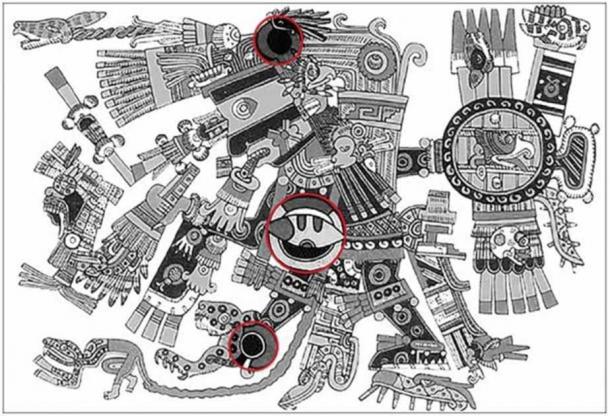
Tezcatlipoca, lord of the smoking mirror, with circular obsidian mirrors on his temple, his chest and his foot highlighted (Codex Borgia) (figure by S. Campbell, after Díaz & Rodgers 1993 / Antiquity Publications Ltd).
9. Angra Mainyu, the Zoroastrian Evil Spirit
Angra Mainyu, also known as Ahriman, embodies evil in Zoroastrianism. He opposes Ahura Mazda, the god of light and goodness, and represents darkness, chaos, and all things destructive. Zoroastrianism is a dualistic religion, meaning it posits a fundamental struggle between the forces of good (Ahura Mazda) and evil (Angra Mainyu). This dualism is at the core of Zoroastrian beliefs and cosmology. Thus, Angra Mainyu is depicted as the embodiment of chaos, destruction, and deceit. He is responsible for spreading chaos, suffering, and falsehood throughout the world. What is more, he is believed to have created a host of evil spirits and demons to assist him in his efforts to undermine the goodness and order established by Ahura Mazda. And, being responsible for various forms of suffering, death, and misfortune in the world, this God is definitely feared by the followers of this very old religion.
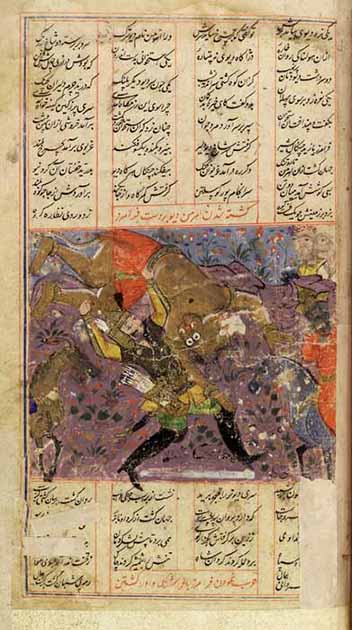
Angra Mainyu (or Ahriman) being slain by Faramarz during a scene from the Shahnameh. (See page for author / CC BY 4.0)
10. Surt, the Fire Giant of Ragnarök
Surt, a fire giant in Norse mythology, is destined to bring about Ragnarök, the prophesied end of the world. He wields a flaming sword and leads the forces of destruction in the final apocalyptic battle. According to the Norse prophecies, during Ragnarök, Surt will lead the fire giants (the sons of Muspel) in a final battle against the gods and their enemies. He is said to have a flaming sword that emits intense heat and blinding light, and is one of the most feared of the fire giants. During Ragnarök, Surt and his legions of fire giants will march forth from the fiery realm of Muspelheim, the land of fire, to engage in battle with the gods. This confrontation will result in the destruction of the cosmos. Surt's flames will engulf the world, causing it to sink beneath the sea, and everything will be consumed by fire. Because of this, many ordinary believers dreaded even the mention of Surt or any of his giants. Being the one to cause the death of all the Norse gods, Surt is definitely a fearsome mythological figure.
- Epic Battle Equals Doom or Twilight for Norse Gods? Ragnarök: The Real Message in the Myth
- Ragnarok: Norse Account of Strange & Wonderful Land Doomed to Destruction – Part I
To Strike Fear Into the Believers
These ancient gods and goddesses, with their formidable powers and often capricious natures, served as reminders of the unpredictable and uncontrollable aspects of the natural world and the human condition. They were often associated with aspects of the natural world and human existence that were both awe-inspiring and terrifying, reflecting the complex and multifaceted nature of ancient mythologies.
Top image: Kali, Hindu goddess of death. Source: super / Adobe Stock.
References
Bremmer, J. N. 2010. Gods of Ancient Greece: Identities and Transformations. Edinburgh University Press.
Coulter, C. R. and Turner, P. 2013. Encyclopedia of Ancient Deities. Routledge.
Fletcher, J. 2020. A Guide to the Viking’s Most Fearsome Gods. Available at:
















